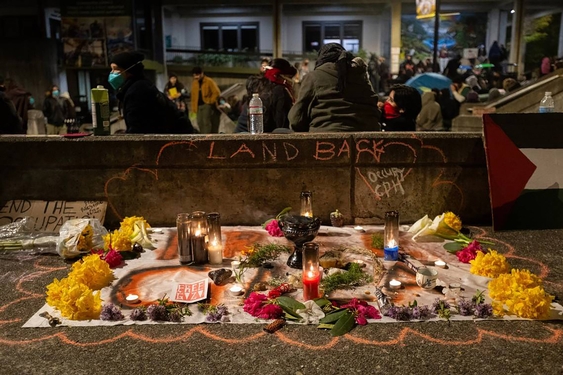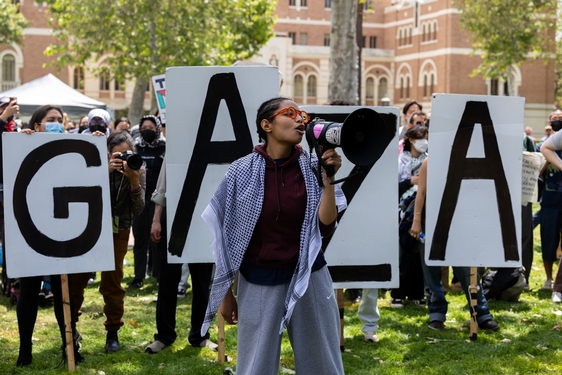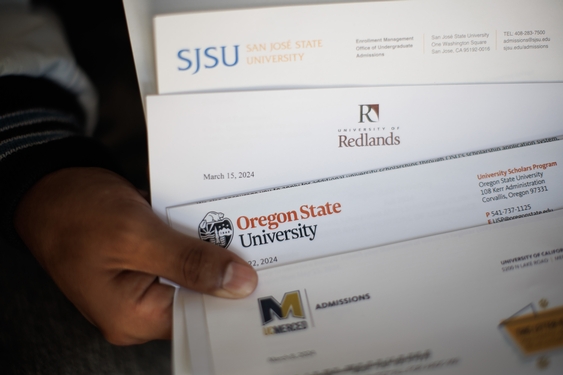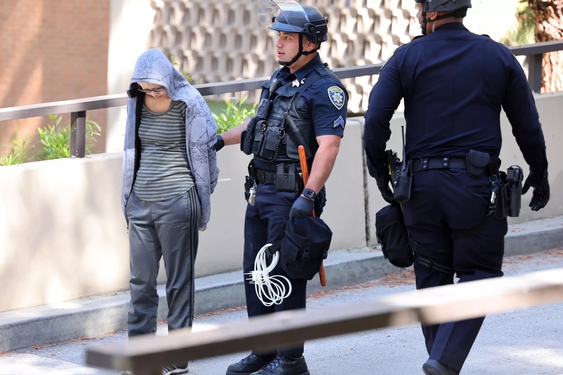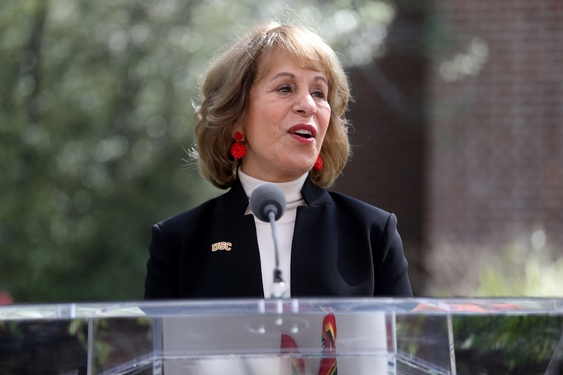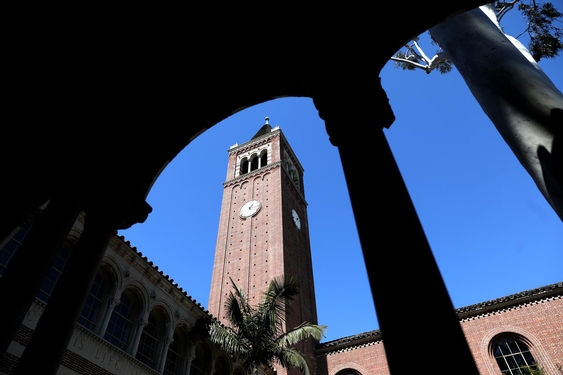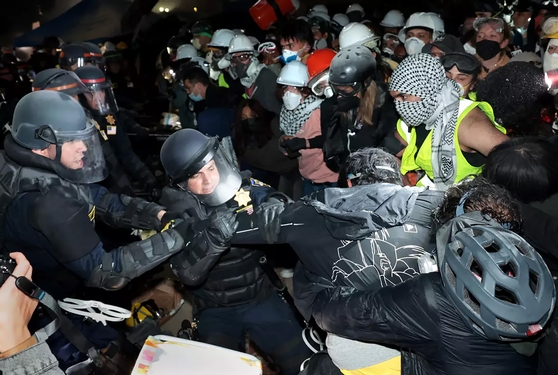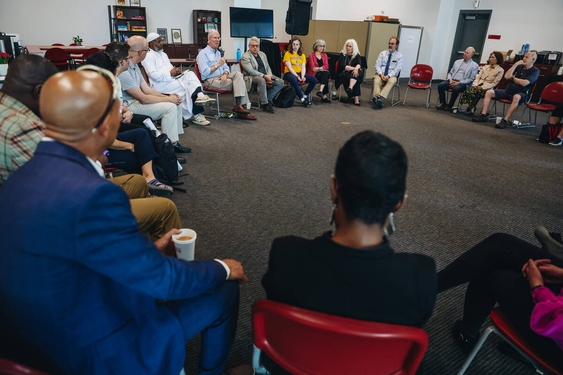Before dawn Tuesday, more than 100 law enforcement officers in riot gear marched into the quad of Cal Poly Humboldt, clutching guns and batons.
They encircled a small group of protesters — including a furry one in a lime-green costume — who knelt on the ground, holding hands and reciting native chants.
“Resistance is justified!” the crowd yelled as officers informed them they were being arrested before pulling them up, one by one, and fastening their hands with zip ties.
The scene capped an extraordinary weeklong protest at this public university that has emerged as California’s strongest epicenter of civil disobedience over Israel’s war against Hamas in Gaza.
Students at the state’s major campuses, including USC and Berkeley, have made the news over the last week. But Cal Poly Humboldt, tucked at the base of a redwood forest in rural Northern California and home to 5,976 students in Arcata, has taken on an out-sized role. Students have engaged in more vigorous disruption, occupying an academic and administrative building, painting buildings with graffiti and twice forcing police to retreat.
Humboldt is one of the smallest and most isolated of the Cal State schools, a hub for students in the rural towns and former logging communities of California’s far north coast and interior.
Yet those on campus understand why it has become such flashpoint.
Faculty leaders say activism is in the college’s DNA, noting that students and professors have practiced nonviolent civil disobedience for more than half a century — from the Vietnam War in the 1960s and 1970s to the forest defense movement of the 1980s and 1990s.
“People ask, ‘Well, why do they occupy? Why don’t they do what everybody else does and sit outside in tents?’ ” said Anthony Silvaggio, the chair of the sociology department.
“It’s because we’re Humboldt,” he said, noting that as a graduate student in 1997 he was arrested during the Headwaters Campaign to save the last remaining old-growth redwood forests. “We occupy space! We have a rich history of taking over space and a long genealogy of direct-action tactics.”
After resisting multiple attempts by police in riot gear to remove them from a building, students renamed it “Intifada Hall.” They scrawled slogans such as “land back,” “destroy all colonial walls” and “pigs not allowed” up and down its corridors and wrote “BLOOD ON YOUR HANDS” across the wood-paneled walls of President Tom Jackson Jr.’s office.
They said they would not leave until the university disclosed all holdings and collaborations with Israel, cut all ties with Israeli universities, divested from companies “complicit in the occupation of Palestine” and publicly called for a cease-fire. They also called for the dropping of any legal charges against student organizers.
Jackson said Tuesday “it breaks my heart” to see arrests. “Unfortunately, serious criminal activity that crossed the line well beyond the level of a protest had put the campus at ongoing risk.”
But some faculty and students reject that narrative, accusing administrators and authorities of escalating a peaceful situation by bringing in riot police the first evening of the occupation. The closure of the entire campus, they argue, was unnecessary.
“These are the actions of conscientious individuals working to end a genocide, not the actions of criminals,” the faculty union, the university chapter of the California Faculty Assn., said in a statement
One of the activists arrested, assistant professor Rouhollah Aghasaleh, vowed to reject any bond and embark on a hunger strike until he and all his students were released.
“I refuse to accept the label of criminal for standing up for an ethical reason.” he wrote in a statement before his arrest.
::
At the heart of the showdown is a dispute that stretches beyond the Middle East to the question of how central activism is to the university’s mission.
Faculty leaders blame Jackson, who became president in 2019 and has overseen the university’s transition to a polytechnic. The new designation, made in 2022, was designed to increase sagging enrollment with high-demand STEM education and research offerings.
Officials hope the changes will result in a better university. But critics accuse Jackson of being out of sync with campus culture and failing to appreciate the university’s long history of environmental and social justice activism.
According to Silvaggio, Jackson has ruffled feathers by telling faculty, “We’re not here to train activists.”
Silvaggio — who said he learned tactics of non-violent civil disobedience from his professors, who were activists on the defense of native forests — now teaches courses in community organizing and social movements.
He noted that last week was hardly the first occupation of a Humboldt campus building: In 2015, students occupied the university’s Native American Forum for a week to protest the abrupt firing of the then-chair of the Indian Natural Resource Science & Engineering Program.
At the time, the university’s president visited the sit-in to talk to students, praising their action as “a real demonstration of your commitment to student access, achievement and completion.”
“Look at our mission,” Silvaggio said, pointing to the university’s purpose and vision statement, which commits to being a “campus for those who seek above all else to improve the global human condition.” It also commits to “partnering with indigenous communities to address the legacy of colonialism.”
Still, the occupation involved far more disruption than the one in 2015. Supporters of the movement acknowledge that they have developed bolder tactics and become more willing to eschew rules and leaders in the last decade with the coalescing of movements such as Black Lives Matter and the Black Bloc.
“There is no organization or leader,” Silvaggio said. “When these rudderless movements happen, you’re gonna have property destruction, vandalism. That’s the natural course of occupations these days.”
::
The occupation of Cal Poly Humboldt began April 22 when students showed up at Siemens Hall, an academic building that includes the university president’s office, with sleeping bags, board games and decks of cards. They barricaded the entrance with chairs and tables and erected a banner that said, “STOP THE GENOCIDE.”
Students planned a peaceful sit-in in the president’s office to protest Israel’s actions in Gaza, said a 23-year-old student from San Jose who asked to be known only as “Mango” because he feared retaliation. Transgender indigenous students started holding a prayer, he said, and then police showed up and started hitting.
The university gave a different account, saying students and faculty had to be evacuated as protesters disrupted classes and vandalized university property. In addition to defacing the building with graffiti, the university said, protesters blocked entrances and elevators with tents and in some locations shut doors using chains and zip ties, violating fire codes and “creating extreme safety hazards for those inside.”
Video taken from inside showed protesters blocked law enforcement from entering, a police officer beat a protester with a baton and a protester beat an officer’s helmet with an empty five-gallon water jug — a scene that swiftly turned viral, inspiring “jug of justice” memes with the catchphrase “Bonk the police.”
Three students were arrested. Citing safety concerns, officials announced a hard closure of campus, first through last Wednesday, then Sunday, and eventually for the rest of the semester.
Hundreds of students living on campus were told they could leave their dorms only if they had a valid reason and could be cited for trespassing.
Aaron Donaldson, a lecturer in the communications department and secretary of the faculty union, said students who tried to leave campus to get groceries complained of confrontations with police. He had 50 outlines to grade, but could not go get them for fear of arrest.
After another standoff Friday — police moved in that evening to enforce an order to disperse, students resisted and police ultimately withdrew — the university again condemned activists, claiming the occupation “has nothing to do with free speech or freedom of inquiry.”
But the administration said it would “continue to talk to anyone willing to have productive and respectful dialogue.”
In a gesture of good faith, the occupiers moved out of Siemens Hall on Sunday, clearing the building and moving their occupation to outdoor space.
::
By Monday afternoon, the tree-lined campus with glimmering views of Humboldt Bay had the feel of a nearly deserted, surreal summer camp.
Activists in pink, brown, and white furry costumes roamed outside the main administration building and quad, which was encircled with barricades of chairs, tables, trash bins and fencing.
After a faculty led teach-in about ablism, there was a march, followed by a Passover seder. As some munched matzo, others chanted: “From the river to the sea.”
As dusk fell, some activists put on goggles and helmets, carried makeshift shields, jangled tambourines and beat drums as they prepared for another standoff with law enforcement.
Just after 9:30 p.m., a patrol car rolled through campus, broadcasting a recorded message urging demonstrators to immediately disperse. If they did not move, protesters could face rubber bullets and chemical spray.
“Cops off campus!” the crowd chanted in unison.
Many faculty, barred from campus, massed on the street outside, saying they wanted to bear witness to what was happening to their students.
Dominic Corva, a professor of sociology, said he blamed Cal Poly Humboldt’s president for creating conditions that led to the standoff.
“This [university] has a president … completely at odds with [the] culture and pedagogy of the university,” Corva said. “His actions have escalated the situation.”
Jackson could not be reached for comment Tuesday. But in a statement, he said: “Our focus for the entire time has been on doing all we could do to protect the safety of all involved, and we were very patient and very disciplined with that.”
Donaldson said the standoff between activists and administrators had reinforced some key lessons of the social advocacy class he taught this semester: Direct democracy, he said, is fundamentally about non-violence and is never convenient; the point is to interrupt and to stop and to say, “Wait, we have to talk and pay attention.”
For Rick Toledo, 32, a student organizer on campus who did not occupy the building but supported the movement, the most pressing concern Tuesday morning was raising $10,000 per person for bail.
There had been some conflicts among activists over strategy and the value of graffiti, Toledo said. But in the course of the occupation, they had tried to come to a consensus and develop some rules.
“When you have varying ideologies and no strict guidelines, clashes are bound to happen,” Toledo said.
Going forward, Toledo hoped activists could develop guidelines before they occupied again.
“The movement can’t die here,” he said. “There’s so much pain in Palestine. What the students have done is huge and we need to keep that momentum.”
___
©2024 Los Angeles Times. Visit at latimes.com. Distributed by Tribune Content Agency, LLC.


